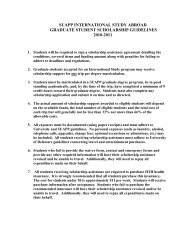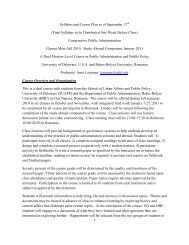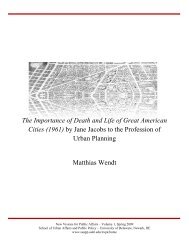New Visions for Public Affairs Volume 1 - School of Public Policy ...
New Visions for Public Affairs Volume 1 - School of Public Policy ...
New Visions for Public Affairs Volume 1 - School of Public Policy ...
Create successful ePaper yourself
Turn your PDF publications into a flip-book with our unique Google optimized e-Paper software.
Wendt, Matthias Death and Life by Jane Jacobs 14<br />
simplify the use that people give to the surrounding<br />
neighborhood, as monotonous areas produce users with<br />
fewer different purposes and destinations. Borders <strong>of</strong> all<br />
kinds divide up cities in pieces. Trouble arises when<br />
districts are bisected or fragmented by borders so that<br />
the neighborhoods are weak fragments and unable to<br />
exist functionally. However, many <strong>of</strong> the institutions<br />
and facilities that chop up cities with borders are<br />
important to cities. Every big city needs universities,<br />
railroads and expressways. Jacobs calls <strong>for</strong> planners to<br />
recognize that these facilities also have destructive<br />
effects that should be countered. Referring to Kevin<br />
Lynch’s Image <strong>of</strong> the City, Jacobs argues that borders<br />
should become a seam rather than a barrier, a line <strong>of</strong><br />
exchange connecting different areas. Many borders can<br />
become more like seams if they placed their uses<br />
intended <strong>for</strong> the public, such as cafés and leisure<br />
facilities, at strategic points on their perimeters (Jacobs,<br />
1961).<br />
Jacobs opposes the attempts <strong>of</strong> the urban renewal laws<br />
to solve the problem <strong>of</strong> spreading slums by eradicating<br />
slums and their populations and replacing them with<br />
upscale projects intended to improve the city’s tax base.<br />
This method usually completely fails, since at best, it<br />
merely relocates slums to another area or, at worst,<br />
destroys lively neighborhoods where improving<br />
communities exist. Jacobs detects the high population<br />
turnover and lack <strong>of</strong> identification <strong>of</strong> the residents with<br />
their neighborhood as the key problems <strong>of</strong> slums.<br />
Overcoming slums thus hinges on the retention <strong>of</strong> a<br />
considerable number <strong>of</strong> residents and business people<br />
pursuing their plans within the slum. Jacobs notes that<br />
an early symptom <strong>of</strong> unslumming is a drop in<br />
population and a constant number <strong>of</strong> dwellings at the<br />
same time. This is a sign <strong>of</strong> increasing attractiveness <strong>of</strong><br />
a neighborhood, as inhabitants have become<br />
economically able to increase their living space. This<br />
process <strong>of</strong> incumbent upgrading needs to be fostered by<br />
planning instead <strong>of</strong> being destroyed by knocking down<br />
whole neighborhoods (Jacobs, 1961).<br />
VII. The Influence <strong>of</strong> Death and Life on Urban<br />
Planning<br />
Death and Life was deeply influenced, apart from the<br />
pr<strong>of</strong>ound changes U.S. cities were undergoing during<br />
the post-war period, by Jacobs’ personal circumstances.<br />
Her life as a young mother in Greenwich Village and<br />
observations <strong>of</strong> the street life in her own neighborhood<br />
directly influenced, as the cited passages show, her<br />
empirical theories. Jacobs wanted to convince her<br />
readers with real-life insights instead <strong>of</strong> academic<br />
knowledge (Laurence, 2007).<br />
When Death and Life was first published in 1961, the<br />
reception was divided. It got a very good public<br />
reception; a <strong>New</strong> York Times reviewer called it "the<br />
most refreshing, provocative, stimulating, and exciting<br />
study <strong>of</strong> this greatest <strong>of</strong> our problems <strong>of</strong> living which I<br />
have seen" (Rodwin, 1961). In the planning field,<br />
however, it was initially treated negatively by the<br />
pr<strong>of</strong>essionals, while architects were divided (Bromley,<br />
2000). Death and Life also had a significant impact on<br />
related disciplines, such as urban sociology; <strong>for</strong><br />
<strong>New</strong> <strong>Visions</strong> <strong>for</strong> <strong>Public</strong> <strong>Affairs</strong> – <strong>Volume</strong> 1, Spring 2009<br />
<strong>School</strong> <strong>of</strong> Urban <strong>Affairs</strong> and <strong>Public</strong> <strong>Policy</strong> – University <strong>of</strong> Delaware, <strong>New</strong>ark, DE<br />
www.suapp.udel.edu/nvpa/home







